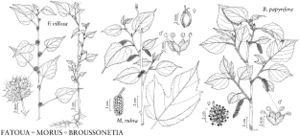Broussonetia papyrifera
Tabl. Règn. Vég. 3: 547. 1799.
Trees, to 15 m. Bark tan, smooth or moderately furrowed. Branchlets brown, spreading pubescent. Terminal bud absent, axillary buds dark brown, short-pubescent; leaf scars nearly circular, somewhat elevated. Leaves: stipules ovate to ovate-oblong, apex attenuate; petiole shorter than or equal to blade. Leaf blade entire or 3-5-lobed, 6-20 × 5-15 cm, base shallowly cordate, often oblique, truncate, or broadly rounded, margins serrate, apex acuminate; surfaces abaxially densely gray-pubescent, adaxially scabrous. Staminate inflorescences 6-8 cm; peduncle 2-4 cm. Pistillate inflorescences ca. 2 cm diam., villous. Staminate flowers: sepals pubescent. Pistillate flowers: style elongate-filiform. Syncarps globose, 2-3 cm diam.; drupes red or orange, oblanceolate, each exserted from its calyx.
Phenology: Flowering spring.
Habitat: Disturbed thickets
Elevation: 0-600 m
Distribution

Introduced; Ala., Ark., Conn., Del., D.C., Fla., Ga., Ill., Iowa, Kans., Ky., La., Md., Mass., Miss., Mo., Nebr., N.J., N.Y., N.C., Okla., Pa., R.I., S.C., Tenn., Tex., Va., W.Va., native to Asia.
Discussion
Broussonetia papyrifera is now widely naturalized in eastern United States. Frequently planted as a shade tree around dwellings, it is often considered undesirable because of its aggressiveness, shallow root system, and soft, brittle wood. The bark of the tree is used to produce a barkcloth.
Selected References
None.
